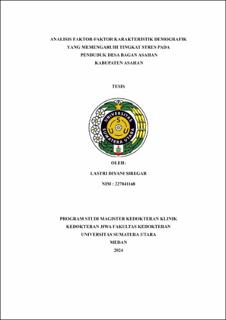Analisis Faktor-Faktor Karakteristik Demografik yang Memengaruhi Tingkat Stres pada Penduduk Desa Bagan Asahan Kabupaten Asahan
Demographic Characteristics Factors Analysis That Influence Stress Levels in Residents of Bagan Asahan Village, Asahan District

Date
2024Author
Siregar, Lastri Diyani
Advisor(s)
Camellia, Vita
Husada, M Surya
Metadata
Show full item recordAbstract
Background: Stress is one among the mental health problems that is growing in prevalence, especially during Covid-19. Nochaiwong (2021) reported a global prevalence of stress during the Covid-19 pandemic of 50%. Residents in disadvantaged areas have an increased risk of stress compared to residents with similar sociodemographic characteristics and socioeconomic status in more developed or developed areas. Bagan Asahan Village is one of the many underdeveloped villages that does not have adequate health facilities, has no health data and only has 3 midwives and does not have a practicing doctor, clinic, treatment center, auxiliary health center (pustu), health center or hospital based on the 2022 data report. The distance from Bagan Asahan Village to the nearest Puskesmas is only about 2 kilometers, but this puskesmas provides services covering 4 villages with a population of around 20,269 people. The lack of health facilities means that this village does not have adequate access to health care, even though with a population of 7,525 people, this village is the most populous village (19.75%) in Tanjung Balai Sub-district. The main livelihoods of residents in Bagan Asahan Village are fishermen and casual laborers. To the best of the researcher's knowledge, reports of stress levels in this village have also never been known.
Methods: The study was conducted using a cross-sectional design on 300 residents in Bagan Asahan Village, Asahan Regency, North Sumatra Province. The tool used in this study was PSS (Perceived Stress Scale)-10 where multivariate logistic regression analysis was used to analyze the association of independent factors including age, gender, marital status, employment status, education level, income level and chronic diseases with perceived stress levels.
Results: In this study, the level of severe stress was 28.7% (96 subjects). There is a significant association between demographic factors and perceived stress levels using the results of Chi square bivariate association analysis, namely occupation (p = 0.02), gender (p = 0.014), income level (p < 0.001) and chronic diseases (p < 0.001). Multivariate analysis showed a significant association between age (OR=1.83, p=0.046), income level (OR=5.95, p<0.001), and chronic disease status (OR=5.3, p<0.001) with perceived stress levels.
Conclusion: There was a higher prevalence of severe stress in deprived villages. Demographic factors shown to be associated with severe stress included female gender, unemployed and low education level. Younger age, low income and the presence of chronic diseases were associated with higher levels of perceived stress among residents in deprived villages.
